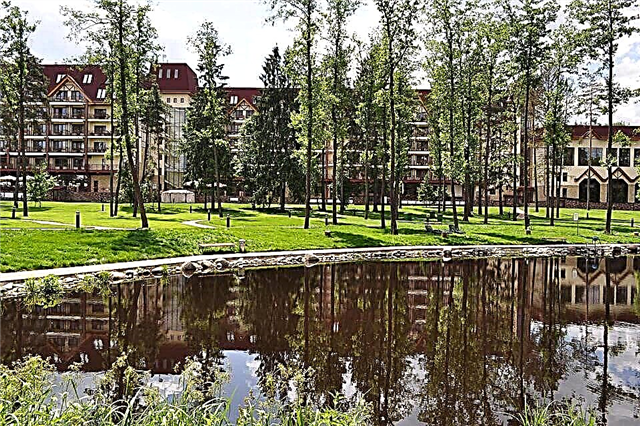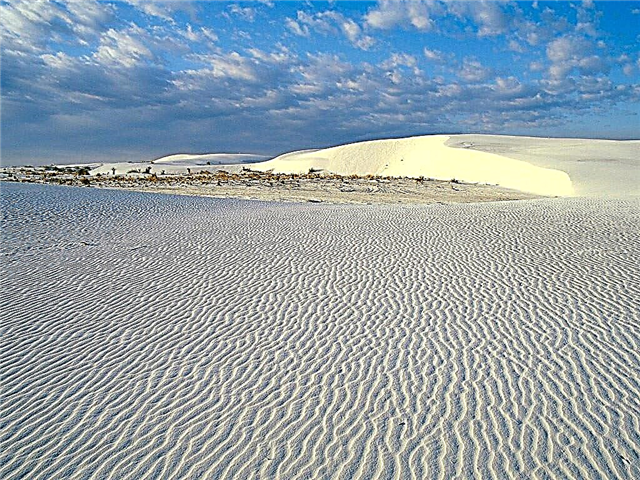Many travel lovers recognize the corner located in the southern part of the USA - next to Mexico as one of the most amazing places in the world. We are talking about an extraordinary desert, which received the name White Sands (White Sands Desert) for the unique color of the surface. By the way, the indigenous population - the Apache Indians - found a more poetic definition for this place: porcelain.
For everyone, sand is associated with yellow or brown: indeed, the Sahara is called yellow, the Gobi - brown. The red Namib desert or the green Kalahari are not surprising either. But most people cannot even imagine that a sandy area with numerous dunes on an area of approximately 700 square kilometers can look like the Arctic or Antarctica.
Nevertheless, this huge space sparkles in the sun, as if covered with the whitest snow, and the dunes look like huge snowdrifts. Only the unbearable heat does not allow tourists to feel like they are in the Arctic.

Where is
The desert lies on a plateau about 1200 m above sea level next to the Sacramento mountain range and the Rio Grande River. In the northern part, it comes into contact with the Mexican Chihuahua Desert - large, but the most common. In this country, in general, sandy areas in the deserts are very rare, so White Sands is also unique for this. But for wanderers, first of all, its incredible whiteness is interesting.
Why is the sand here white
Experts explain such an unusual view by the fact that the desert does not consist of quartz sand, as usual. The earth in this place is covered by a substance that is a type of gypsum called selenite. In large quantities on the surface, it is very rare, since it is easily soluble in water.

Recall that gypsum deposits arise as a result of the evaporation of salty sea water. Of course, this is a very long process: in White Sands, it began about 100 million years ago. Scientists explain the changes that took place as follows: initially there was a shallow sea in this place. Drying up, it turned first into small bays, then into salt lakes.
At the bottom, from which the water receded, there were particles of salt and gypsum. A few tens of millions of years later, tectonic movements of the earth's crust began here, as a result of which mountain ranges were formed (now they are called Sacramento and San Andreas). Their tops turned out to be made of selenite. Under the influence of sediments, the selenite layers dissolved and flowed down, and already on flat ground, the gypsum sediment there again crystallized, forming a selenite crust.
How to apply for a US visa yourself - a detailed guide for independent tourists.

But nature did not calm down: the wind crushed the selenite crusts into small grains of sand, carried them around the neighborhood, laid them in the dunes. This is how the area now known as White Sands, a US national monument, was formed. The snow-white selenite hills are 18 m high, 8 km wide and 40 km long. They do not stand still, but move slowly in a northwest direction.
When moving, sometimes one of the dunes covers the other (they seem to climb on top of each other), then very unusual-looking two-story dunes are obtained. Tourists like not only to look at marvelous landscapes, but also to walk barefoot on the purest sand: even in the heat, it does not burn their feet. Selinite reflects the rays of the sun and, as a result, does not get very hot. People who have been in the desert say that it is easy to walk on it - it is dense and the legs do not sink much.

How to get to the USA on your own - read our article.
Fauna of the desert
Lovers of living creatures are unlikely to be pleased with the White Sands Desert. Both flora and fauna are very scarce here, despite the fact that rains in this region are not uncommon. Plants do not take root here because of the constantly moving sand. Only unpretentious yucca and poplar can withstand such soil: poplars have a very long root system (up to 30 meters), which allows them to fix in one place, and yuccas, although they are carried from one place to another by the wind, easily take root again. In addition to these plants, in the less hot outskirts of White Sands, there are centaury, abronia, echinocactus and even the so-called desert melon.
Another interesting place in America that deserves attention is the Eternal Flame Waterfall.
How to travel around the USA - a useful life hack.

Most of the living creatures also do not live in the center of the desert. Only lizards and baggy rats are found there. Moreover, these animals differ from their relatives from other regions in an unusually light color: they had to adapt to local conditions and mimic the surrounding white background. At the foot of Sacramento and San Andreas, the fauna is more diverse: there are coyotes, skunks, porcupines, ground squirrels, badgers, shrews and other animals.
Although in the daytime you won't see anyone here either: all the animals hide from the exhausting heat in holes or thorny thickets. Animal life manifests itself only when the Sun is hidden behind the horizon. Many animals are distinguished by a very unusual appearance, which is eloquently evidenced by their names: zebra-tailed lizard, antelope hare, grasshopper mouse. There are also such animals that you will not find anywhere else - for example, the gila-toothed. At the same time, there are practically no poisonous reptiles here; only the black rattlesnake is found in the porcelain desert. It is not difficult to avoid a collision with him: the approach immediately becomes known by the characteristic crackle.
We also recommend visiting the Coral Castle and Jacob's Well.

Legends and myths
The White Sands Desert was discovered in the middle of the 19th century by the American military, and in 1933 it became a national natural monument. The uniqueness and originality of this place has given rise to many legends and myths. In particular, people who are convinced of the existence of extraterrestrial civilizations talk about the fact that White Sands is the landing site for UFOs.
Ufologists say that alien ships have been seen here many times. Others believe that Indian tribes regularly come here to communicate with the spirits of their ancestors. It is possible that these rumors are spread on purpose: stories about UFOs or Indian customs do not frighten, but rather attract travelers.

The military has also chosen the desert. It was in White Sands in 1945 that the first atomic bomb was detonated, and now in the northern part of the park there is a testing range for various weapons. But let's reassure: tests are carried out only on specially designated days, at other times you will not find anything like this here, and you can safely admire the unique views, have picnics and take pictures for memory.
Park opening hours and ticket prices
The park is open daily except December 25, when Christmas is celebrated in the United States. Usually it can be visited from 8 to 20.00, but in some periods of the year the time may change slightly depending on the weather conditions: there are sandstorms here. In addition, the strictest rule applies: tourists must release the territory of the reserve from their presence immediately after sunset, at night the entrance to the park is prohibited. In addition, all visitors must be registered in a special log - both at the entrance and at the exit. This is necessary so that, if something happens, rescuers come to the rescue in time: there were cases when people lost their way.

You will have to pay for a visit: the entrance ticket for adults is $ 3, for children under 15 years old - $ 1.5. Entrance tickets are sold at the entrance. For visitors, there are roads along which you can move by cars, as well as walking paths marked with high orange posts (again for safety reasons).The road is 12 km long.
Entertainment
Hikers can walk along four routes - along the most beautiful places of the desert and where the largest concentration of albino animals is seen.

The administration of the national park, in addition, offers some entertainment: you can ride on the sand on special sledges or snowboards; periodically, hot air balloon festivals are organized in the desert. Chief among them is the White Sands Balloon Invitational. It is held once a year in the third week of September and lasts 2 days.
The festival, as a rule, attracts representatives of all American states to demonstrate their creations to each other and to guests. Guests of the holiday are allowed not only to enjoy the magnificent spectacle and watch the actions of the balloonists, but also to climb into the sky and get an idea of what this amazing place looks like from above.

How to get there
The closest landmark for those wishing to visit the White Sands Desert is the town of Alamogordo. It is located 25 km from the reserve. The town can be reached by regular bus, taxi or car from any city in New Mexico. The journey will take about an hour and a half. The nearest airport is El Paso, located 130 km from White Sands - in Texas. From here, transfers are organized to Alamogordo, where travelers can stay at a hotel or camping.
Best time to visit
Seasoned travelers recommend coming to White Sands in winter: during this period there are not too many tourists here, and the winter sun is reflected in a special way in selenite crystals, which makes the area even more fantastic. By the way, if there is a desire to take a picture, it is better to do it in the morning or in the evening - in low sunlight, when natural shadows most favorably emphasize the relief of the sands.











